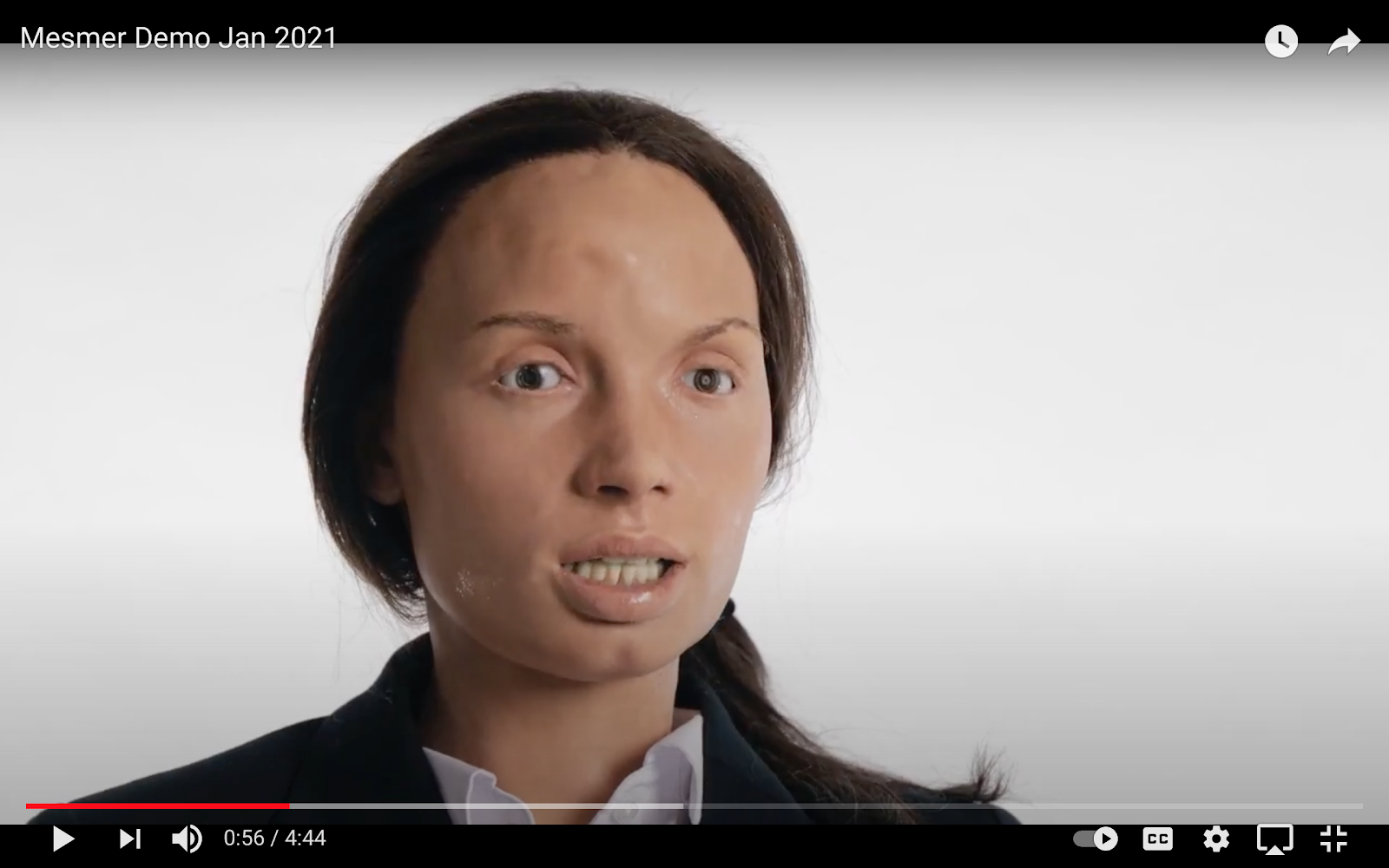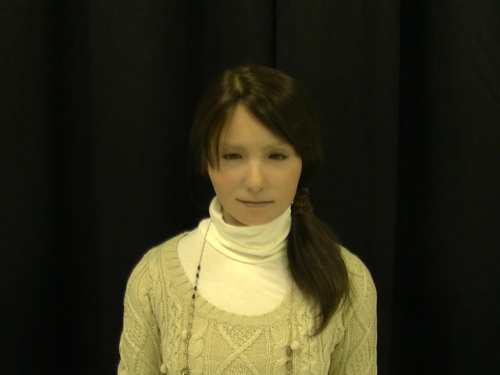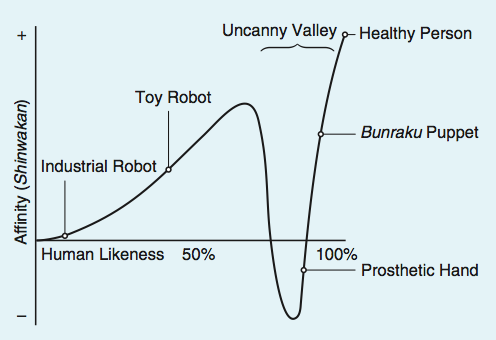America's Uncanny Valley
Posted by <Bella K> on 2021-06-21
AMERICA'S UNCANNY VALLEY
by Bella Kozyreva
Uncertain. Familiar. Eerie. To exist in the immediate American era is to exist in the uncanny valley. But maybe taking a closer look can awaken our weakened political imaginations.

In 1970, Masahiro Mori, a robotics professor at the Tokyo Institute of Technology, published an essay on how we tend to feel about the way robots look. Mori theorized that when robotic machines have certain human-like features, people like these machines more. But as the robotic machine appears increasingly closer in resemblance to humans, a threshold is reached. Mori reasoned that within this space, where there is a close resemblance but not an exact replica of the human form, we suddenly become repulsed. Suddenly, we are creeped out.

He modeled the effect with a line graph, in which there is a striking visual representation of a peculiar caveat in our affinity for human-like robots. The line sharply plummets at a margin of likeness not-quite-fully human. This is what Mori coined bukimi no tani, popularly translated as “the uncanny valley”. At the time of publishing his article made few waves. Despite being an intuition and not something researched, his position struck a chord with robotics scholars some 40 years later. Though the theory has seen contestation from the scientific community, studies have found evidence of the effect and it remains food for thought with regards to engineering artificial intelligence. And as advances in technology yielded increasingly realistic humanoid robots, the uncanny valley theory captured the imagination of a public already living in a world where AI virtual assistants are found in everyone’s pockets.
Our encounter with the uncanny valley unsettles and disturbs us. When we enter the valley, proximity to the human form goes from being perceived as appealing to feeling sinister. The focus is shifted to the how object is not replete with- but rather devoid of humanness. Chasms now appear between what is fully human and what is just malformed.

The phenomenon is a nonlinear function of how varying degrees of familiarity influence affective response. Ultimately, it projects (at least one category of) our perceptual evaluation, and reveals it to be incongruous in addition to conditional. But beyond this, there is a poetic aspect to the uncanny valley. It suggests the borders between embrace, cognitive dissonance, and revulsion may be thin. Additionally, with its invocation of in-betweenness, we are reminded that this is often a state of discomfort. There is a conspicuousness to the interstitial space. The valley seems to point out that resemblance and familiarity, while possibly indicating something good, can also signal the need for caution.
When we are in the uncanny valley we are confronted with deviations and idiosyncrasies. This opens up a space for critical examination of what is being deviated from. “What is the visual standard for the face and movements of a living human? What biases does the standard form? How does it guide our interpretation of other faces?” We are led to acknowledge the archetypes in our lives and the hidden boundaries they may forge within us. By this logic, uncanny valleys may be found elsewhere. Wherever we have paradigms, narratives, or even ideologies, do we even question them— do we even see them? Or do they remain invisible, until some wind has shifted us and we've suddenly tumbled down into some eerily alternate place.
—
In January of this year, in a pyre of economic, public health, and social crises, the Trump presidency smoldered out. It gave way to an administration which had campaigned under the promise of a “return to normalcy”. Beyond just provoking a reflexory pessimistic eye roll, the Biden promise of “normalcy” warrants closer attention; in its invocation of the Obama years it makes clear that the hues of life under the hand of a centrist liberal governing body have become the most lucid, the most real-feeling paradigm of life in America. In the “normal” to which Biden refers, we had witnessed the crude playing out of corporate bailout disguised as economic relief, of depoliticization, of the continued consumption of human life by the logic of markets, of bloodshed overseas. This was de facto American foreign policy and life under global capital. The crude reality is that even for Gen Xers and the generation of Millennials who were coming of age, it was accepted as a standard of normalcy. We could imagine nothing else.
If the Obama years, with their “rational” bailouts and “reluctant” stewardship of U.S. power, represented the most archetypal vision of contemporary America, the Trump years represented an aberration of that. The Trump administration— which will spawn a procession of its own historical accounts on the Barnes & Noble shelves— will be marked by internet babel, fissuring of political opinion brought on by carnivalesque culture wars, disorienting erosion of shared reality, and a palpable sensation of chaos. In the post-Recession landscape, each presidential administration has also cultivated a range of affective analogues to its political aesthetic. Most recently with Trump, for a supporter it may have been righteous satisfaction, pseudo-patriotism, or frenzied conspiratorial climaxing. For a non-supporter, it may have been righteous indignation, abject horror, or even a smug comfort in knowing you were Good in your opposition to The Orange Man. (For some, “Not my president” was both a badge and a security blanket.) Regardless of which you were, the Trump era was a novel havoc for the American landscape.


The effects associated with each administration fall on strata so comparatively distant that we can plot the last fourteen years on a graph like Masahiro Mori’s. While 2008-2016 was bog-standard familiarity (the right side of the graph), 2016-2020 felt utterly foreign, an out-of-the-ordinary yet menacing zone (the left side of the graph). And the valley- the peculiar, indeterminate, emergent moment- is now. The uncanny valley theory becomes an analogy for dominant political narratives, political aesthetics, and the effects they provoke.
The theory may be viewed an allegory for capitalist realism itself. Ultimately, the graph on which the valley lies is a merely a gamut of familiar political realities, varying in how closely they resemble the dominant social, economic, and political paradigm in the American imagination. Beyond these possibilities we cannot see. Our current moment is a deviation from the last four years, but the long-awaited structural refurbishment of material circumstances it seems to be promising may just deliver another impotent political reality that we can too easily recognize.
The Biden administration was predicted by some to mirror the same inefficacies of the Obama era. News media now is steadily molding a spectacle around how much this is certainly not the case, primarily due to the passing of a colossal $1.9 trillion COVID relief bill. While we could have low expectations for the extent to which our country will negotiate the precarity of so many, sweeping immediate economic assistance does provide a sigh of relief. Distributing checks to individuals was the right thing to do in the moment. But— it’s worth considering the real forces behind the recent wave of social welfare overtures. It has long become clear that neoliberalism has entered a new phase. Both Republicans and Democrats have realized austerity policies won’t win elections, eschewing deficit hawking in favor of mega spending. This is the era of the proverbial “money printer go brrrr”. The expensive relief plan, in addition to only being made possible by this seismic shift in the climate of government lending and spending, was also politically requisite for a new president. It’s no surprise that domestic proposals like the PRO Act would feel odd coming from Biden, a lifelong conservative democrat. We should remember to attribute these changes to the buildup of popular pressure, to longstanding organizing efforts from the left, but most apparently, to the absolute devastation brought about by COVID.
Flashbacks of older days return when it comes to foreign policy on the horizon. On February 4th, Biden outlined his ambitions for the nation’s role overseas:
“…the message I want the world to hear today: America is back. America is back. Diplomacy is back at the center of our foreign policy… we must start with diplomacy rooted in America’s most cherished democratic values: defending freedom, championing opportunity, upholding universal rights, respecting the rule of law, and treating every person with dignity.”
The phrase "America is back" gives pause. What is that supposed to mean really? How different is it from something like Trump’s “America First”? There is a clear tension between populism appealing to the revitalization of American business and foreign involvement reflecting American interests and “values”. Foreign policy for Biden will likely be a metric by which the administration can measure flourishing of life at home. Unfortunately, history has shown us that this involves leaving our purported values in the dust. An account of how we are already doing this right now warrants deeper explanation but it includes: maintaining a relationship with Saudi Arabia after the sanctioned murder and dismemberment of an American journalist; recognizing the leadership of Juan Guaidó in Venezuela; continuing a hardball brutal sanctions game with Iran; initiating a dubious pullout from Afghanistan which will likely leave further destruction, endangerment of women and children, and yet another power vacuum in its wake.
Between the “normal version” of America that continues to haunt us, and the suspicious-seeming pseudo-welfare state that the Biden admin is being touted as, the feeling is a strange fog of uncertainty. It’s uncanny. In the slurry of clear reflections and clear breaks from the past, the only thing that seems certain is that we are in a liminal moment, hoping our heels hit the earth as we step.
—
Masahiro Mori’s uncanny valley phenomenon has frequently been compared to Freud’s concept of “the uncanny”. Freud called this the unheimlich (Freud, 1919). The term had only been roughly translated as “uncanny”, however, it more closely meant “the unhomely” feeling brought about by some experience. Mori’s phenomenon and Freud’s unheimlich are analogous in that the unsettling derives from registering something in the outside world as familiar. By a psychoanalytic interpretation, an external world appearing disconcertingly familiar is simply the function of a psychological state, and ultimately, the internal machinations of the psyche (for Freud, this would be repression and castration anxiety). The fundamental concern of the unheimlich is the self.
In The Weird and the Eerie, Mark Fisher (2016) suggested the unheimlich could be flipped around. Rather than viewing the uncanny as an internal phenomenon, more could be revealed about the uncanny (and the disquiet it induces) by understanding it to be generated by the external. For Fisher, the uncanny is simply the range of sensations spanning unease to a turbulent sort of dread. These are what is manifested by the weird and the eerie— forces and circumstances exclusively stemming from the outer world. The weird and the eerie are categorically distinct, though something may be eerie in one sense and weird in another. The weird is something disturbingly intrusive and foreign entering our realm. The weird can trespass or invade. It juxtaposes itself into our world as something which does not belong. While the weird centers around non-belonging, the eerie is about anomalous absence and presence. As Fisher puts it:
“The weird [may be] marked by an exorbitant presence, a teeming which exceeds our capacity to represent it. The eerie, by contrast, is constituted by a failure of absence or by a failure of presence. The sensation of the eerie occurs either when there is something present where there should be nothing, or is there is nothing present when there should be something.”
A bird’s cry can be eerie in that it might contain something beyond just animal reflex, perhaps some kind of intent not associated with birds: something where there should be nothing. Abandoned cities or ruins are eerie in their lack of people, containing nothing where there should be something.
The question of agency, and the uncertainty around it, is another defining aspect of the eerie:
“What happened to produce these ruins, this disappearance? What kind of entity was involved? What kind of thing was it that emitted such an eerie cry? As we can see from these examples, the eerie is fundamentally tied up with questions of agency. What kind of agent is acting here? Is there an agent at all? These questions can be posed in a psychoanalytic register — if we are not who we think we are, what are we? — but they also apply to the forces governing capitalist society. Capital is at every level an eerie entity: conjured out of nothing, capital nevertheless exerts more influence than any allegedly substantial entity.”
If we were to look at it from Fisher’s view, the Biden era we are living in is eerie.
On the one hand there is the appearance that the next four years might go against expectations. The materialization of policies resembling a progressive agenda is eerie. It goes against our baseline anticipation of who will see relief from the state and of progressive issues receiving nothing more than lip service on the campaign trail— all of which by Fisher's definition is a failure of absence. On the other hand we notice that changes being proposed are eerily devoid (a failure of presence) of non-superficial, long term policies meant to bolster the working class. Then there is the issue of indeterminate agency. Over the past year, many of us may have acutely felt that the world is happening to us and we have little sway over it. The agents, even if we can guess what they are, are invisible. The coronavirus, an invisible agent, has sown a plague across the globe. It has callously taken loved ones from us and rearranged our lives with a terrifying power. There is no clear higher motive that we can appeal to. As Fisher astutely points out, capital works in much the same way. Following the combustion of protest after the death of George Floyd, loss of jobs and mass displacement, an atrociously politicized pandemic, and disparities in COVID resources across the global south, the failures of capitalism are laid bare. Hundreds of thousands of preventable COVID deaths have served as tragic proof that the framework of global capital is not capable of protecting human life. We’ve been shown that economic policy itself is derived from something ultimately formless. Its rules are illusory.
It is exactly when such controlling forces of society are revealed to be illusory that the weird and eerie harbor a unique revolutionary potential. With the exposure of tired frameworks, reverting to old ways is a non-option. The only acceptable models for moving forward are entirely new ones. Weird ones. A thrilling clarity follows, which Fisher recognizes as sort of jouissance: with the outmoding of conventional and familiar concepts comes a mix of not only pain, but also pleasure. If the weird signals we are in the presence of something new, then we should not only embrace it but actively cultivate it. In the eerie we find archetypal policies that do nothing to tackle a spectrum of issues from racial and class inequality, global human welfare standards, to environmental collapse. The work ahead lies in modeling new futures which depart entirely from the familiarity of the eerie. We must move towards something which, by familiar standards, does not belong. We must become— as Fisher might have perhaps pegged it— weird. This will beg novel ideas but also novel approaches. For one, it is imperative we abandon and extricate ourselves from folk politics by becoming oriented towards the formulation of demands. As Nick Srnicek and Alex Williams (2016) put it in Inventing The Future: “A politics without demands is simply a collection of aimless bodies. Any meaningful vision of the future will set out proposals and goals.” Organizing around clear-cut demands comes in, but so does thinking outside of the confines of existing political narratives. Do not legitimize debates between $1400 or $2000 stimulus checks. Do not be impressed by massive spending if it will not amount to strengthened worker power. Refuse to negotiate the end of The End Of History on its own terms.
The old schema are proven gruesome. This disquieting sensation is just a sign that we’re still in similar depths. Regardless of what season, year, or presidential term, market logic remains insidiously incorporated into almost every facet of our material lives, lodged where it should have no place, governing the most basic of human needs: shelter, education, creative fulfillment, healthcare. It governs sickness. It governs death. It coopts our frustration, our irony, our rebellion. It joins the protest with us, a ghoul by our side.
The only way out of the uncanny valley is to zoom out of it until eventually we see it is merely a point on a continuum of obsoletes. We can abandon the familiarity haunting us in favor of shaping a reality untethered to the old paradigms and the old specters. From way up here, we can start envisioning new alternatives.
SOURCES
Fisher, Mark. The Weird and the Eerie. London: Repeater, 2016.
Freud, Sigmund, and Hugh Haughton. The Uncanny. Translated by David McLintock. London: Penguin, (1919) 2003.
Institute for Memetic Research & Development. Money printer go BRRR. Accessed May 19, 2021. https://brrr.money/.
Mori, Masahiro. "The Uncanny Valley". IEEE Robotics & Automation Magazine 19, no. 2 (1970): 98–100.
Sachs, Jeffrey D. “Joe Biden Could Be The Most Transformative President In 75 Years.” CNN. March 5, 2021. https://www.cnn.com/2021/03/04/opinions/joe-bidens-big-chance-sachs/index.html.
Sopel, Jon. “Biden 100 Days: What We All Got Wrong about Him.” BBC News. BBC, April 27, 2021. https://www.bbc.com/news/world-us-canada-56903805.
Srnicek, Nick, and Alex Williams. Inventing the Future: Postcapitalism and a World without Work. London: Verso, 2016.